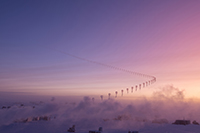2022-2023 USAP Field Season
Project Detail Project TitleU.S. Department of Commerce NOAA Global Monitoring Division (GMD) Summary
Event Number:
Program Director:
ASC POC/Implementer: Principal Investigator(s)
Dr. Ariel NMI Stein
Project Web Site: Location
Supporting Stations: McMurdo Station, South Pole Station DescriptionThe National Oceanic and Atmospheric Administration (NOAA) Earth System Research Laboratory Global Monitoring Division (ESRL-GMD) will continue long-term measurements of ultra-violet (UV) radiation that influences climate and the ozone layer. The observations are made in conjunction with ongoing worldwide measurements of carbon dioxide, methane, carbon monoxide, aerosols, water vapor, surface and stratospheric ozone, chlorofluorocarbons, and the ozone layer. The measurements are used for time-series analysis of multi-year data focusing on stratospheric ozone depletion, trans-Antarctic transport and deposition, the interplay of trace-gas aerosols with the solar and terrestrial radiation fluxes on the polar plateau, the magnitude of seasonal and temporal variations in greenhouse gases, and the development of polar stratospheric clouds over Antarctica. Field Season OverviewAt South Pole Station, operational requirements will continue as before, with the use of the Atmospheric Research Observatory (ARO) for the NOAA instrument suite and the management of the Clean Air Sector. A minimum of two NOAA personnel will staff the observatory year-round, performing upgrades and routine maintenance on the instruments. The need for space and logistics support for balloon launching will continue. The use of helium will continue with no changes. Air samples will be returned to NOAA/GML in Boulder, Colorado on a regular schedule for analysis of carbon dioxide and other trace constituents. Cargo, mail, supplies, and communications support are required. At McMurdo Station, one field team member will spend approximately seven days servicing the UV instrument located at Arrival Heights. During the site visit, the McMurdo Station Research Associate (RA) may be requested for no more than two hours per day to aid in completing visit activities including training updates. The RA provides year-round support for the instrument with daily checks, routine calibrations, and troubleshooting (as needed). Training of the RA on the UV system is requested with five training days in Boulder, CO or at BSI in San Diego, CA prior to deployment. Deploying Team Members
|
2022-2023 Science Planning Summary



For USAP Participants |
For The Public |
For Researchers and EducatorsContact UsU.S. National Science FoundationOffice of Polar Programs Geosciences Directorate 2415 Eisenhower Avenue, Suite W7100 Alexandria, VA 22314 Sign up for the NSF Office of Polar Programs newsletter and events. Feedback Form |



